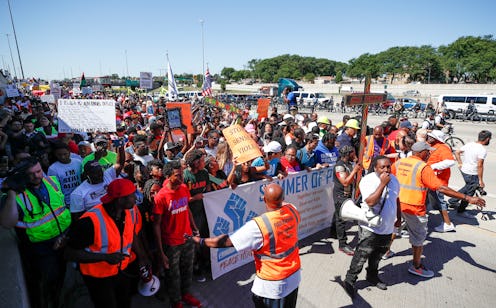News
These Photos Of Chicago's Gun Violence Protest Show People Are Tired Of Waiting For Change

Thousands of protestors marched on Chicago's Dan Ryan Expressway Saturday afternoon, shutting down a portion of the highway. The marchers want elected officials to take action to stop high rates of gun violence in some of Chicago's neighborhoods, according to the Associated Press. These photos of the Chicago protests against gun violence show that community members are tired of waiting for change.
Police said that they had agreed to allow protestors on a portion of the highway, but march leader Rev. Michael Pfleger later said protestors wanted to shut down the entire highway, according to The Hill. The reverend argued that the city closes roads for parades and special occasions, CBS News reported.
After about an hour standstill with police officers, protestors succeeded, at least for part of the march, with police officers closing all northbound lanes. Rev. Jesse Jackson, who also joined the protest, reportedly told demonstrators via a megaphone, "We will not march on the side of the highway. We're marching on the highway," according to The Hill.
The protestors advocated for "national common sense gun laws," and for their communities, more resources, jobs, better schools, and economic development, according to CNN.
Twitter user Dr. Brenna Demands, @BrennaDemands, tweeted powerful photos of the march that included grandparents holding signs of children with the caption "my grandkids want to play outside." She captioned one such photo: "Mothers and grandmothers take to the streets to call for Chicago to #EndGunViolence! Children can't even play outside, we need to put the guns down!"
In April, 600 people had reportedly been shot in Chicago since the start of 2018, according to The Chicago Tribune. Over Memorial Day weekend, 36 people were shot, according to USA Today, which reported that the number marked a "reduction in gun violence" on that weekend from the past two years.
The same USA Today article reported that, as of May 29, there had been 821 shooting incidents in 2018, which means there were more than 200 incidents in the month since the Chicago Tribune article reported its numbers. Still, USA Today noted there had been 1,032 shootings by this time last year.
Specifically, protestors targeted Chicago Mayor Rahm Emanuel, a Democrat, and Illinois Gov. Bruce Rauner, a Republican, to direct more resources toward Chicago's south side, "where economic isolation and gang activity has driven runaway crime rates," according to NBC News.
Gun enthusiasts often argue that Chicago is the best example for why more strict gun laws don't actually prevent violence, with many — including President Trump, during a 2016 presidential debate — arguing that Chicago has the in the "toughest gun laws in the United States," while also having one of the highest rates of gun crimes, according to NPR. White House Press Secretary Sarah Huckabee Sanders even parroted the same talking point after the Las Vegas shooting, when a gunman killed 58 people and left 851 injured, NPR reported.
The problem with the talking point is that it's just factually wrong. Despite having laws that are more strict than many other states — it requires licenses and permits to buy a gun and also has waiting periods between application and purchase — Illinois doesn't have the strictest gun laws in the United States. And Chicago only has one additional law on top of those two: there's an assault weapons ban in Cook County, NPR reported.
But, more importantly, gun laws don't encourage gun crime. Experts have found that what actually increases gun crime in some cities like Chicago is the gun policy of neighboring states. Wisconsin and Indiana have some of the weakest gun laws in the country. And, a 2015 study on guns in Chicago found, according to NPR:
... more than 60 percent of new guns used in Chicago gang-related crimes and 31.6 percent used in non-gang-related crimes between 2009 and 2013 were bought in other states. Indiana was a particularly heavy supplier, providing nearly one-third of the gang guns and nearly one-fifth of the non-gang guns.
Data from the Chicago Police Department and the Bureau of Alcohol, Tobacco, Firearms and Explosives has corroborated the study's findings.
Some officials in Chicago seem to be listening, though, both to the data and to protestors like those who turned out Saturday morning. Chicago Police Superintendent Eddie Johnson was photographed marching side by side with both Rev. Jackson and Rev. Pfleger, according to The Tampa Bay Times. Johnson has repeatedly spoken out in support of gun violence prevention laws.
But some leaders seemed to miss the point of the protestors' messages. Gov. Rauner tweeted on Saturday, according to The Hill:
This is unacceptable. We had clear parameters that allowed the protestors to be heard while respecting law and order. Instead, they chose instead to cause chaos. I’m disappointed in the Mayor. There was an agreement in place. I am calling on the Mayor to take swift and decisive action to put an end to this kind of chaos. I will work with him in good faith and urge him to do his job so that the people of Chicago feel safe.
The last sentence of the governor's statement is perplexing, because the "people of Chicago" were marching on Saturday, and their messages about gun violence and their communities were asking him to do just that: keep them safe.